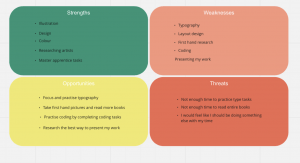Todays lecture was the last one before our easter break and Daniel went over the final part of our semester this year. It was to design your own portfolio website. He talked through examples and how to make a successful one.
To start of the lecture Daniel showed us that here are a few things to consider before starting to design a portfolio:
- Voice and Tone
- Considered content
- Visual cohesiveness
He then set us a task to do, this task was slightly difficult because I had to ask myself questions on mom strengths and weaknesses etc, and this can be tricky sometimes. He had us complete a SWOT (strengths, weakness, opportunities and threats) table and I completed mine on MIRO,
SWOT
Daniel then asked us this week to write a mission statement before we begin designing our portfolios so we are aware of want we want to achieve with this portfolio etc. This is the next thing I have to do.
We then had a class task over on Miro and Daniel asked us to write onto a post-it what we think our portfolio is for. I wrote down that my portfolio is to ‘show my work and my skills’. Below is a snapshot of the whole classes opinions of what they think a portfolio is for and what is it to them.
Hierarchy
The next ask we had was to see put the most important meanings of a portfolio into a hierarchy. The one on the left is what the class believed to be the correct order, and the one on the right was Daniels correct order of importance. He made it clear that the most important reason for a portfolio for any designer is to show their work.
It was interesting to see what others thought making a portfolio was for and why having one was important.
Content Planning
The next section of the lecture was on content planning and what we actually include. Daniel said that our element collages will help us in this part. He also said that we should consider the formatting and placement of elements.
Some ideas that I could include:
- Imagery
- Content
- Bio
- Diagrams
- Text
- Contact details etc
I also have to think about if I want my portfolio to be 1 page or be a multi-page portfolio. Daniel warned to not start our portfolios with ‘Hello I am..’ because this is very common and is seen a lot throughout the design industry.
Inspiration
Daniel then showed lots of examples from different designers and websites that will help me in this process. For example he recommend that we look at SFCD.com because they have a great case study, so I plan on looking at them.
SFCD
He also suggested eta for web standards a good website to look at is Mediaqueires.cm
Whats the next step?
Daniel suggested that our next step should firstly be research into portfolios that we find interesting for inspiration and then to start wireframing. He suggested that we should draw 20 boxes out on an A4 sheet for different ideas for a layout. Then repeat in a larger scale for more details. This will help with the flow of idea and generate more possibilities. I plan on doing this.
He then talked about what follows this task so I made a flow chart on miro.
He finished the lecture by giving some tips
- Be ambitious – explore animation/transitions etc
- Step out of your comfort zone and try something new




